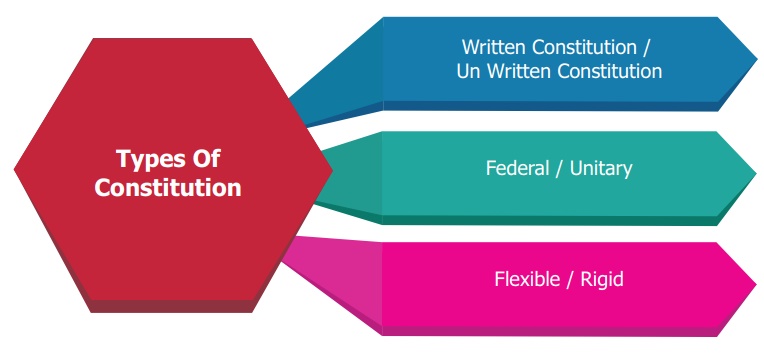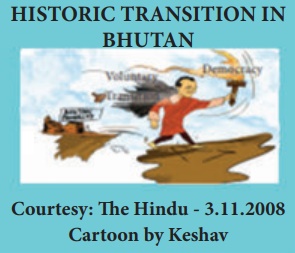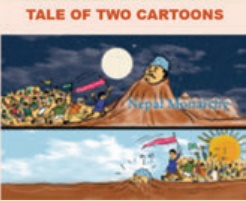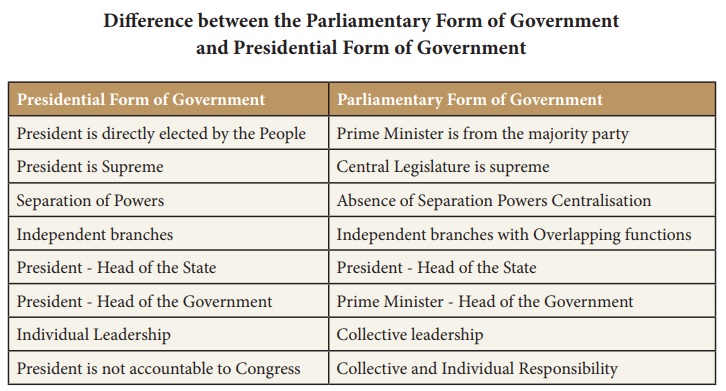Merits, Demerits, features | Forms of Indian Government - Types of Indian Constitution | 9th Social Science : Civics: Forms of Government
Chapter: 9th Social Science : Civics: Forms of Government
Types of Indian Constitution
TYPES OF CONSTITUTION

Unitary Form of Government
A unitary system of government or unitary state, is a sovereign
state governed as a single entity. The central government is supreme and the
administrative divisions exercise only powers that the central government has
delegated to them.
England, France, Japan and SriLanka are examples of Unitary Form of governments.
In a Unitary form of government, all the authority and power is vested in a single centre, whereas
in a federal form of government authority and power is distributed
between centre and
the constituent units. Even in a Unitary form of Government, there might be a lot of decentralisation of authority,
but we cannot claim it as a federal
system.
Merits of unitary form of government
•
Suitable
for small countries.
•
There is no conflict of authority and
responsibility.
•
A unitary government will make prompt decisions and take speedy action.
• A unitary government is less expensive.
•
Amendments to the constitution are easy.
•
There is unity,
uniformity of law, policy
and administration.
De-merits of unitary form of government
•
It is not suitable
for big countries.
•
The central
government will have to tackle so many complex
problems that lead to administrative delay
•
The central government
will not concentrate on local
problems, local interest
and initiative.
•
The concentration of powers may pave
way for the despotism of the central government.
Unitary features of the indian constitution
• Strong Centre
• Central Government’s
control over state territory
• Single Constitution
• Flexibility of the
Constitution
• Unequal
representation of states
• Emergency Provisions
• Single Citizenship
• Single Integrated
Judiciary
• All India Services
• Appointment of
Governor by the central government
Federal form of government
The classification of governments into unitary and federal is based on the nature
of relations between the national and the regional governments.
A federal government is one in
which powers are divided between the national government and the regional
governments by the Constitution itself
and both operate
in their respective
jurisdictions independently. U.S.A, Switzerland,
Australia, Canada, Russia, Brazil, Argentina have federal form of governments. In a federal
model, the national
government is known as the Federal
government or the Central
government or the Union government and the regional government is known as the state government or the provincial government.
Merits of federal form of government
•
Reconciliation
of local autonomy
with national unity
•
Division
of power between centre and states leads to administrative efficiency
•
It gives
rise to big states
•
Distribution of powers check the despotism of central government
•
More suitable for bigger countries
•
It is good for economic and cultural progress
De-merits of federal form of government
•
Federal government is
weaker when compared to the unitary government.
•
Federal
government is
more expensive
•
Provincial
tendencies are very common
•
Lack of uniformity in Administration
•
Threat to national
unity
•
Distribution of powers between centre and
states lead to conflicts
•
Double Citizenship
•
Rigid constitution cannot be mended easily
for changing needs
•
The
state governments sometimes place hindrances in the foreign policy

Federal features of the Indian
constitution
•
Dual Government
•
Written Constitution
•
Division
of Powers
•
Supremacy of the Constitution
The Constitution is the supreme
law of the land.
The laws enacted
by the Centre
and the states must
confirm to its provisions.
•
Rigid Constitution
•
Independent Judiciary
•
Bicameralism
Difference between Unitary form and Federal form of Government

Unitary Form of Government
·
Only one Level of
Government or Sub units
·
Mostly Single Citizenship
·
Sub Units cannot operate
independently
·
No Division of Power
·
Centralisation of Power
Federal Form of Government
·
Two Levels of Government
·
Dual Citizenship
·
Federal Units are
answerable to Central Government
·
Division of Power
·
Decentralisation of Power
Parliamentary form of government
Modern democratic governments
are classified into parliamentary and presidential on the basis of the nature
of relations between the executive and the legislative organs
of the government.
The parliamentary system of government is the one in which the
executive is responsible to the legislature for
its policies and
acts.
The parliamentary government is also known as cabinet government
or responsible government or Westminster model of government and is prevalent in Britain, Japan, Canada and India among
others.
Features of parliamentary form of government
• Nominal and Real Executives
• Majority Party Rule
• Collective Responsibility
• Dual Membership
• Leadership of the Prime Minister
Merits of the parliamentary form of government
• Harmony between Legislature and Executive
• Responsible Government
• Prevents Dictatorship
• Wide Representation
Demerits of the parliamentary form of government
• Unstable Government
• No Continuity of Policies
• Dictatorship of the Cabinet
• Against Separation of Powers
The presidential form of government
The Presidential Form Of Government is also known as non-responsible or non- parliamentary or fixed executive system of government, basically built on the principle of separation of power and is prevalent in the USA, Brazil, Russia and Sri Lanka among others.
Features of presidential form of government
The American President is both the head
of the State and the head of government. As the head of State, he occupies a
ceremonial position. As the head of government, he leads
the executive organ of the government.
The President is elected by an electoral college for a fixed tenure of
four years. He cannot be removed by the Congress, except by impeachment for
a grave unconstitutional act.
The President
governs with the help of a
cabinet or a smaller body called ‘Kitchen Cabinet’. It is only an advisory body and consists
of non-elected departmental
secretaries. They are selected
and appointed by him, are responsible
only to him and can be removed by him any time.
The President and his secretaries are not responsible to the Congress for their acts.
They neither possess membership in the
Congress, nor attend its sessions.
Historic Transition
in Bhutan
Third King
- Abolishment of slavery
Fourth King
- Abdication of regal title
Fifth King - Democratic elections and establishment of local self-government
Transition from the hereditary
monarchy to the Parliamentary Democracy. In 2006, the king abdicated the throne 34 years after ascending it. His son
Crown Prince Jigme Khesar
Namgyel Wangchuck became the fifth monarch
and head of the
state of the Himalayan kingdom. Now
Bhutan is a Parliamentary Democracy and King Jigme a constitutional monarch.

The President
cannot dissolve the House of
Representatives—the lower house
of the Congress. The doctrine of separation of powers is the
basis of the American presidential system. The legislative, executive and judicial powers of the
government are separated
and vested in three
independent organs of the government.
Merits of the presidential system of government
•
Democratic
•
Effective
Control by the President
•
Facilitate decision-making
•
State government
Demerits of the presidential system of government
•
Can
degenerate into
Dictatorship
•
Strain relationship between executive
and legislature
•
Lack of Harmony
between the Legislature and Executive
April Revolution and democracy in Nepal
On April, 2006 the leaders of Nepal vibrant pro-democracy civil society movement “Seven
Party Alliance” (SPA)
called for a million
strong demonstration to be
staged at 7 different
points along the Ring road encircling the capital Kathmandu.
The millions of citizens who made up the people's
movement demanded an end to autocratic
rule of monarchy and Restoration of total
democracy in the Himalayan kingdom. An unprecedented
development forced King Gyanendra to step down and paved the way
for democracy

Difference between the Parliamentary Form of Government and Presidential Form of Government

Presidential Form of Government
·
President is directly
elected by the People
·
President is Supreme
·
Separation of Powers
·
Independent branches
·
President - Head of the
State
·
President - Head of the
Government
·
Individual Leadership
·
President is not
accountable to Congress
Parliamentary Form of Government
·
Prime Minister is from the
majority party
·
Central Legislature is
supreme
·
Absence of Separation
Powers Centralisation
·
Independent branches with
Overlapping functions
·
President - Head of the
State
·
Prime Minister - Head of
the Government
·
Collective leadership
·
Collective and Individual
Responsibility
The relationship between the Centre and the State in India
India is a union of States where the power is shared between the
centre and the states, as per the procedures mentioned in the Constitution of
India. Though the powers are shared between the Central and State Governments,
the final decision is by the Central government in all matters. The
relationship between the centre and the states are
1.
Legislative relations
(Articles 245-255)
2.
Administrative
relations (Articles 256-263)
3.
Financial
relations(Articles 268-293)
Both the Central
and State governments have the power to make laws,
but the matters differ. The centre can make laws applicable to the whole nation on certain
matters called as
the
union list. The States have the powers to make laws
in some matters
only, applicable to their own
state, called
as the State list.
The concurrent list
includes the subjects
on which both Central and State government have the power to make laws.
Union List:
Union
list has 100
subjects. These include
Foreign affairs, Defence, Armed forces,
Posts and Telegraphs, inter-state trade and commerce
and so on.
State List: The state list consists of 61 subjects, which include Public
order in the state, police, prisons, Local Governments, agriculture and so on.
Concurrent List: The Concurrent list has 52 subjects which include Criminal and
Civil procedures, marriage and divorce, economic and special planning,
newspapers, books and printing presses, population control and so on.
THE CONCEPT OF GOVERNANCE
From Government to Governance
Good governance is an indeterminate term used in the
international development literature to describe how public institutions conduct
public affairs and manage public resources. Governance is 'the process of
decision-making and the process by which decisions are implemented'.
'Government' and
'governance' are synonyms, both denoting the exercise of authority in an organization, institution or state.
Characteristics of good governance
• Participation
• Rule Of Law
• Transparency
• Responsiveness
• Consensus
Orientation
• Equity
• Effectiveness And
Efficiency
• Accountability
Gross National Happiness (GNH):
Gross National Happiness is a
developing philosophy as well as an 'index' which
is used to measure the collective happiness in any specific
nation.The concept was first mentioned
in the constitution of
Bhutan, which was enacted on 18 July
2008.
The term 'Gross National Happiness'
was coined by the fourth
king of Bhutan,
Jigme Singye Wangchuck,
in the 1970s.
The GNH’s central tenets are: “Sustainable and equitable
socio-economic development; environmental conservation;
preservation and promotion of culture; and good governance”.
GNH is distinguishable by valuing collective happiness as the
goal of governance and by emphasising harmony with nature and traditional
values.
Related Topics